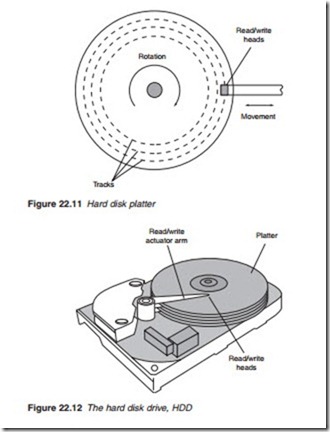Hard disk recording
Data recording on a hard disk drive (HDD) is carried out in the same way as recording on an electromagnetic tape in which a thin magnetic surface is magnetised by a flux produced by an electromagnetic head gap. The disk rotates at a constant speed and data in the form of 0 and 1 bits are written along concentric tracks as shown in Figure 22.11. To retrieve the data from the disk, a read head is used and the process is reversed. Early hard disks used a single read/write head. Later, metal-in-Gap (MIG) heads were used, and today thin film heads are common. With these later technologies, the read and write head are separate units, but are placed on the same actuator arm.
The hard disk consists of a number of rigid disks called platters made of aluminium covered with a thin layer of magnetic coating and placed in a sealed container. A separate read/write heads are provided for each active
platter surface as shown in Figure 22.12. Each active surface is formatted into a number of tracks known as cylinders and each cylinder is divided into a number of 512-Byte sectors. The disks rotate at a very high angular speed of up to 10,800 rpm and can have a capacity of over 300 GB. The sealed container keeps dust and other contamination away from the sur- face allowing the read-write heads to float on a cushion of air very close to the disk surface which helps to increase the potential size of the disks. The hard disk could be part of a personal computer for general use or dedicated to a single task as in the case of Sky+, personal video recorders (PVRs) and twin tuner terrestrial DTV receivers. In all cases, the video and audio must be digitised and compressed before it is stored on the disk.
